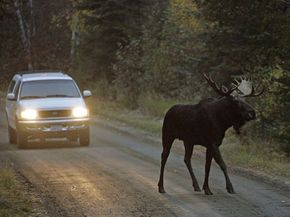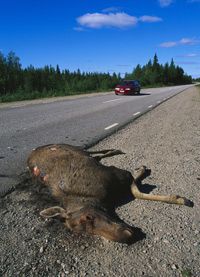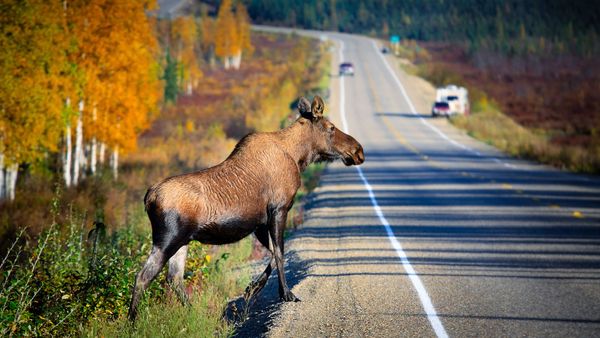After your alarm goes off for the umpteenth time, you finally drag yourself out of bed, brew some coffee and stumble out the door. You offer up a silent prayer that traffic will be kind to you today, but as you listen to the morning traffic report, you know that fate is not on your side: A tractor trailer has overturned on the main road and there's a 10-car pileup on your alternate route. Determined not to be late, you take a chance on the back roads. But as you slam on your brakes after rounding the second curve, you realize today is just not your day.
Your mind wanders through the possibilities of what's holding up this line of cars -- a school bus, maybe? Or some idiot driving a pathetic 20 mph (32 kph) under the speed limit? Nope, you're in Alaska, and for the third time this month, you're late to work because of a giant deer, looming at a height of 6.6 feet (2 meters) and weighing in at 1,600 pounds (725 kilograms). That's right -- your reputation for punctuality is being tarnished by a moose.
Advertisement
If you lived somewhere like New York City or London, having your commute interrupted by such a hulking beast might actually be exciting. But in Alaska, where there's at least one moose for every four people, seeing this animal wander the streets during winter is expected [source: Rausch and Gasaway, U.S. Census Bureau].
While some people are entertained when moose in Alaska nibble on their shrubbery or join in the morning commute, others are less enthused. Female moose, or cows, are highly protective of their young and if they feel threatened, even if it's unwarranted, they won't hesitate to attack. Similarly, adult males can become very aggressive during mating season and may decide to take that aggression out on an annoying dog and its owner.
In 2007, an overprotective cow attacked a boy innocently playing in his backyard. In a separate incident the same year, a college student was trampled to death by a moose that wandered on the university's campus [source: Clarke]. While such incidents are rare, altercations between moose in Alaska and cars are fairly common. An average of 600 automobile accidents involving these animals occur each year, causing about $9 million in damage. During an especially harsh winter in 2003, the state saw 1,300 collisions that incurred costs of more than $18 million [source: Alaska Moose Foundation].
You don't have to be an expert tracker to find one of these guys. In fact, moose may be the ones that seek you out during the winter.
Advertisement




